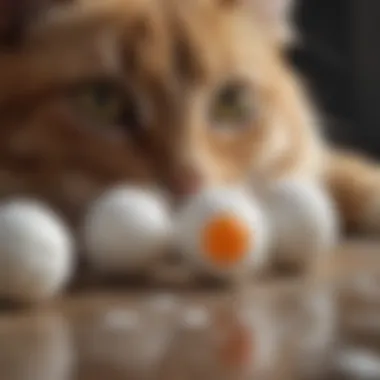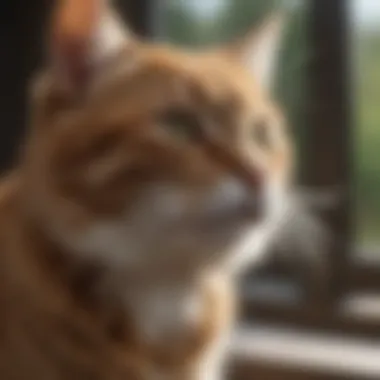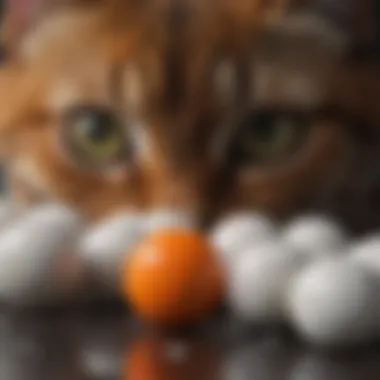Investigating Mothballs as Effective Cat Repellents


Intro
Mothballs are often used in homes for various purposes, primarily for the prevention of moth damage in stored clothing and fabrics. However, an intriguing claim has emerged: that mothballs may also serve as effective repellents against cats. This inquiry raises important questions about the safety and reality of this assertion. The primary components of mothballs, typically naphthalene or paradichlorobenzene, have distinct smells and properties that may influence animal behavior. In this examination, we will analyze the genuine effectiveness of mothballs as cat repellents, address the potential risks involved, and explore alternative methods for keeping felines at bay.
Animal Overview
Common Name and Scientific Classification
Cats, commonly known as domestic cats, belong to the family Felidae. Their scientific name is Felis catus. As one of humanity's oldest companions, they have adapted to various environments around the world.
Physical Characteristics
Domestic cats display a diverse range of physical traits. They typically weigh between 5 to 20 pounds, with various coat colors and patterns. Their keen senses allow for exceptional hunting abilities, featuring sharp retractable claws, anatomical features precisely suited for predation, and acute hearing.
Habitat and Distribution
Domestic cats can thrive in various habitats, from urban settings to rural landscapes. They are found globally, often sharing close quarters with humans. Their adeptness in adapting to different environments contributes to their widespread presence.
Behavior and Social Structure
Communication Methods
Cats utilize a variety of vocalizations and body language to communicate. Purring, hissing, and meowing are among the sounds they use. They also express their feelings through tail positions and ear movements.
Social Hierarchies
While domestic cats are often solitary by nature, they can exhibit complex social behaviors. Interaction with other cats may establish hierarchies, influencing feeding and mating behaviors. Some cats form colonies, especially in resource-rich areas.
Mating and Reproductive Behavior
The breeding season for domestic cats usually occurs during warmer months. A solid understanding of their mating rituals can help identify the best times to manage populations effectively. Female cats exhibit strong mating calls to attract males, resulting in a gestation period of about 64 to 67 days.
Conservation Status
Current Population Trends
Domestic cat populations vary widely. Some areas experience overpopulation, while others see a decline. Understanding these patterns is crucial for managing their impact on local wildlife.
Threats and Challenges
Domestic cats pose a significant threat to wildlife, particularly bird populations. They can also face threats from vehicular accidents and diseases if not properly cared for.
Conservation Efforts and Success Stories


Various initiatives aim to manage feral cat populations through spaying and neutering programs. Many communities are engaged in responsible cat ownership and education to minimize their ecological impact.
The intersection of cats and mothballs as a deterrent raises critical issues concerning safety and efficacy. The chemicals in mothballs can pose risks not only to cats but also to humans.
In the following sections, we will delve into the chemical makeup of mothballs, their application around pets, and the examination of their effectiveness in repelling cats.
Prologue to Mothballs
The topic of mothballs is pivotal to understanding their effectiveness as a repellent for cats. Mothballs, often used in homes to protect clothing and other fabrics from moths, have gained attention for their alleged ability to deter felines as well. This section will delve into the definition and purpose of mothballs, while also shedding light on the common ingredients found in these products. Such knowledge is crucial for pet owners, veterinarians, and wildlife biologists who are concerned about both the safety of their animals and the practicality of using mothballs as repellents.
Definition and Purpose of Mothballs
Mothballs are small balls or pellets that release a strong-smelling chemical vapor. Their primary function is to prevent moths and other insects from damaging clothing and textiles. They do this by emitting vapors that are toxic to these pests, effectively driving them away. Typically, mothballs are used in closed environments, like closets or storage bins, to provide a barrier against infestations. However, many pet owners wonder whether this means that mothballs can also be effective in keeping cats at bay.
Common Ingredients in Mothballs
There are key ingredients commonly used in mothballs that contribute to their insect-repelling properties. These include:
- Naphthalene: This is the most prevalent active ingredient in many traditional mothballs. It is a white crystalline solid that can vaporize easily, releasing its strong odor.
- Paradichlorobenzene: This compound is another common ingredient. It is derived from benzene and has similar characteristics to naphthalene, providing an alternative in some mothball products.
Both of these substances are known for their pungent smells, which may also be unpleasant or irritating to cats and other animals. Understanding these ingredients is essential, as they raise concerns about the safety of these products when used around pets and humans.
Understanding Cat Behavior
Cats' Olfactory Perception
Cats rely heavily on their sense of smell. Their olfactory receptors are highly developed, allowing them to detect scents at concentrations up to 100 times lower than humans can perceive. This keen sense not only guides them in hunting but also in social interactions and territorial assessments. Mothballs contain naphthalene or paradichlorobenzene, both of which produce strong odors.
For cats, these smells can be overwhelming. Their sensitivity to scents may cause aversion or distress. The chemical composition of mothballs influences how cats respond to these products. Understanding this is crucial when considering their use in homes with cats. Moreover, the compelling scent of mothballs can either repel or attract depending on the cat's past experiences and individual preferences.
Predatory and Territorial Instincts
Cats are inherently predatory and territorial. They establish their boundaries and communicate with other animals through scent marking. This instinctual behavior shapes their interactions with the environment and other species, including humans.
Mothballs disrupt the natural scents in an area. The strong odors can alter how cats recognize familiar grounds, possibly leading to confusion or anxiety. This unsettling reaction can push a cat to avoid treated areas, offering some measure of deterrence. However, it is essential to note that relying solely on mothballs may not address the root causes of territorial behaviors. Instead, understanding why a cat behaves a certain way is vital in managing unwanted behaviors effectively.
In summary, a thorough understanding of cat behavior helps evaluate the potential impact of mothballs and other deterrents. Their olfactory perception and instinctual behaviors communicate how they engage with their surroundings. Pet owners must approach the discussion of mothballs with care, knowing that while these products might have repelling effects, they also present risks and complications that demand attention.
Mothballs and Their Repelling Effect
The topic of mothballs and their purported effectiveness in repelling cats holds significant relevance for pet owners and animal behavior researchers alike. Understanding the nature of mothballs is crucial in evaluating their potential role within a domestic environment. While these small, aromatic balls are commonly thought to deter pests like moths, their effect on felines is often taken for granted. Therefore, it is essential to analyze how the chemical makeup of mothballs influences cat behavior, as well as what research has indicated about this topic.
Chemical Composition and its Implications
Mothballs are typically made from two primary chemical compounds: naphthalene and paradichlorobenzene. Both of these substances possess strong odors, which are believed to function as a deterrent for various insect species, particularly moths. However, the question remains—do these chemicals affect cats in the same manner?


Naphthalene, a polycyclic aromatic hydrocarbon, creates a pungent scent that felines may find unappealing. A study published in the Journal of Veterinary Behavior indicated that cats, with their highly developed sense of smell, might respond negatively to the scent of naphthalene. Conversely, paradichlorobenzene has different properties that can be toxic not just to cats but also to humans. The inhalation of vapors from these mothballs can lead to respiratory issues in both species. As such, the implications of using mothballs as cat repellents extend beyond simple efficacy, extending into potential health risks.
Cats' Reactions to Mothballs
Cats are known for their sensitivity to changes in their environment, particularly odors. When exposed to mothballs, they may exhibit various reactions based on their individual temperament and prior experiences. Some cats may exhibit avoidance behaviors, steering clear of areas where mothballs are placed. Others may display interest towards the source of the smell, which could lead to unwanted ingestion or exposure.
Common reactions include:
- Avoidance: Reluctance to enter or stay in areas with mothballs present.
- Curiosity: Investigation of the odorous source, potentially leading to harmful exposure.
- Discomfort: Signs of distress can manifest as vocalizations or attempts to leave the vicinity.
These responses highlight the fact that while some cats may indeed avoid areas treated with mothballs, others might be drawn to them, presenting a significant risk.
Research Findings on Mothballs and Cats
Research surrounding mothballs as cat repellents is limited but telling. A study conducted by the Companion Animal Behavior Therapy Study Group found that while cats often avoided areas treated with mothballs, the toxicity concerns raised questions about the safety of such practices. Reports indicate that the chemical composition not only fails to guarantee a long-term repelling effect but also poses serious health risks.
Furthermore, anecdotal evidence from various pet owner communities suggests that several alternative deterrents provide safer options without the associated risks. Utilizing behavioral training and natural repellents like citrus or lavender may prove to be more effective and safer for both cats and other pets in a home environment.
Key Takeaway: Mothballs may repel some cats, but the potential health risks are significant. Safe alternatives should be considered.
In summary, while mothballs might seem like a practical solution to deter cats, their effectiveness is questionable, and the associated health risks compel individuals to seek safer methods for managing feline behavior.
Health Risks Associated with Mothballs
Understanding the health risks associated with mothballs is essential when discussing their use as cat repellents. While mothballs can deter cats, they can also pose significant hazards not only to pets but to humans as well. This section aims to outline these risks, providing a clearer picture of whether their use is justifiable within a home environment where cats and people coexist.
Toxicity Concerns for Cats
Mothballs primarily include either naphthalene or paradichlorobenzene. Both substances can be toxic to cats. When inadvertently ingested or inhaled in significant amounts, these chemicals can lead to various health problems.
Symptoms of mothball toxicity in cats may include:
- Vomiting
- Diarrhea
- Lethargy
- Difficulty breathing
- Skin irritation
- Neurological signs such as tremors or seizures
The severity of the symptoms can vary based on the quantity ingested relative to the cat's size. In serious cases, exposure can be fatal. It is crucial for pet owners to be aware of these potential dangers. If a cat shows any signs of distress after exposure, seeking immediate veterinary attention is necessary.
Effects on Humans and Other Pets
Mothballs are not just harmful to cats; humans and other pets are also at risk. The fumes emitted by mothballs can be harmful, especially to children and individuals with pre-existing health issues such as asthma or other respiratory conditions.
Potential effects on humans include:
- Nausea
- Headaches
- Respiratory irritation
- Long-term health consequences with prolonged exposure


Moreover, small animals like dogs can experience similar health issues as cats when exposed to mothballs. Signs of distress in these pets might include:
- Vomiting
- Excessive drooling
- Lethargy
In light of these health risks, the use of mothballs in households with animals or children should be approached with great caution.
There are numerous alternative methods for achieving similar goals without exposing pets and humans to harmful substances. Understanding these risks helps inform better choices that prioritize health and safety while addressing the need for effective cat repellents.
Alternatives to Mothballs for Repelling Cats
The narrative surrounding the use of mothballs as cat repellents raises significant concerns for pet owners. While mothballs may provide some level of deterrence, the health risks associated with their use are paramount. This highlights the need for safer alternatives. Exploring natural repellents and behavioral strategies can lead to more effective and humane means of keeping cats away from undesired areas.
Natural Repellents
Natural repellents offer a holistic approach to deter cats without the associated risks of chemical exposure. Many natural substances are unpleasant to cats, making them effective alternatives. Some popular natural repellents include:
- Citrus scents: Cats typically dislike the smell of citrus fruits. Spraying diluted lemon or orange juice around areas can create a barrier that cats will avoid.
- Vinegar: The strong scent of vinegar can be off-putting for cats. A mixture of water and vinegar places can deter feline intrusion.
- Herbs and plants: Certain plants such as rosemary, lavender, and rue can act as natural repellents because cats find their smells unpleasant. Planting these around gardens or using essential oils can provide an effective solution.
- Coffee grounds: The strong aroma of used coffee grounds can repel cats. Dispersing coffee grounds in areas where cats frequent can serve as an inexpensive deterrent.
Utilizing these natural alternatives not only minimizes risks to pets but also promotes an environmentally friendly approach to pest control. When selecting a repellent, it is essential to observe your cat’s reactions and adjust accordingly to ensure the chosen method effectively keeps them away without causing stress.
Behavioral Strategies to Deter Cats
Addressing the behavioral aspects of cats can offer significant benefits in managing their presence in undesirable areas. Rather than relying solely on repellents, implementing strategies that redirect their natural instincts is effective. Here are some practical methods:
- Discouraging exploration: Creating physical barriers such as fencing or using motion-activated devices can deter cats from wandering into certain spaces. Cats generally avoid areas where they may feel threatened.
- Positive reinforcement: Training cats through positive reinforcement can encourage them to adapt their behaviors. Using treats when they display desired behaviors can redirect their attention elsewhere.
- Creating designated play areas: Fostering an enriching environment with suitable toys and engaging activities can keep cats off limits. Ensuring they have stimulation reduces their need to explore unapproved areas.
- Routine consistency: Establishing a routine helps cats feel secure. When they have set times for food, play, and exploration, they are less likely to wander into areas they should avoid.
Implementing these behavioral strategies requires patience and consistency. Understanding cat behavior and modifying environments can lead to effective deterrence.
Using a combination of natural repellents and behavioral approaches presents a comprehensive method to deter cats effectively.
In summary, exploring alternatives to mothballs for repelling cats remains critical. With natural remedies and behavioral strategies, pet owners can protect their furry companions while maintaining an inviting environment. Consider the specific needs of your household and choose the methods that resonate best with your pet's well-being.
Closure on the Use of Mothballs Around Cats
The utilization of mothballs as a deterrent for cats presents a complex interplay of effectiveness, safety, and practicality. Understanding this topic is crucial for pet owners who may seek solutions for keeping their homes cat-free. In this article, we have investigated the chemical properties of mothballs and how they interact with feline behavior. Many people expect mothballs to provide a quick fix for unwanted feline visits. However, the potential health risks to both cats and humans must also be a focal point when considering their use. Effective repellent solutions should take into account not only immediate needs but also the longer-term concerns for all living beings in a shared environment.
Final Thoughts on Effectiveness
Mothballs have traditionally been associated with repelling pests, including cats. However, their actual effectiveness is not as clear-cut as some may believe. While the strong odor of mothballs might dissuade some cats, many may ignore the scent altogether.
Studies indicate varied responses among cats when confronted with mothballs, highlighting that individual behavior plays a significant role in their reaction. Thus, while mothballs may work for some situations, they are unreliable as a definitive solution for cat control. Pet owners must weigh the advantages against the potential adverse effects.
Mothballs might deter some cats, but their health risks and inconsistent effectiveness make them a less desirable option for long-term use.
Recommendations for Pet Owners
For those looking to manage cat behavior around their homes, there are safer and more effective alternatives to mothballs. Here are several recommendations:
- Natural repellents: Consider using scents that are known to deter cats such as citrus, lavender, or certain essential oils. These options can create unfriendly environments for cats without the health risks.
- Physical deterrents: Implementing barriers like fences or mesh can limit feline access to gardens or specific areas in a yard.
- Behavioral training: Training techniques that reward desired behaviors can help manage cat presence in unwanted spaces.
- Consider humane solutions: Engaging with local animal control or rescue groups can provide insight on managing stray cat populations without harm.
A comprehensive approach that prioritizes animal welfare and human health will yield better results than relying solely on mothballs.







